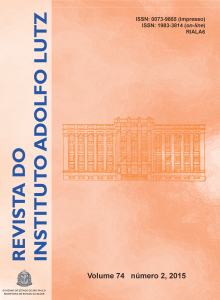Abstract
Lagoa dos Patos estuary is an important artisanal fishing pole because it represents an area for breeding several species of fish and shellfish. Water is directly influenced by meteorological factors, which interfere in the ocean water into the estuary and flow, reflecting on the salinity. For this reason, there is the possibility of V. parahaemolyticus be found in the lagoon estuary; consequently the fish caught from these place could offer risks to the health of consumers. The objective of this study was to evaluate the presence of V. parahaemolyticus in the Lagoa dos Patos estuary, and in the fishes captured from small-scale fishing and processing. Fifty-six samples of fish caught from the Lagoa dos Patos estuary were analyzed for the presence of V. parahaemolyticus. Three of five species analyzed, shrimp (Farfantepenaeus paulensis), mullet (Mugil platanus) and sole (Paralichthys orbignyanus) harbored this microorganism. These results serve as a warning for providing the best technical oversight to the production of fish, and also the adoption of hygienic and sanitary measures to prevent the risk of transmission of this pathogen to consumers. This is the first report on the isolation of V. parahaemolyticus from F. paulensis, M. platanus and P.orbignyanus.
References
1. Heitmann IG, Jofre LM, Hormazabal OJC, Olea A, Vallebuona C, Valdes C. Review and guidelines for treatment of diarrhea caused by Vibrio parahaemolyticus. Rev Chil Infectol.2005;22(2):131-40. [DOI: 10.4067/S0716-10182005000200003].
2. Reis EG. Pesca artesanal na Lagoa dos Patos: História e administração pesqueira. In: Alves FN. Por uma história multidisciplinar do Rio Grande. Rio Grande: FURG; 1999. p.81-4.
3. Instituto Brasileiro do Meio Ambiente e dos Recursos Naturais Renováveis - IBAMA. Desembarque de pescados no Rio Grande do Sul. Porto Alegre: CEPERG/Ibama; 2002.
4. Leal LCN, Bemvenuti AM. Levantamento e caracterização dos peixes mais freqüentes no mercado público do Rio Grande. Cad Ecol Aquat.2006;1(1):45-61.
5. Möller O, Fernandes E. Hidrologia e hidrodinâmica. In: Seeliger U, Odebrecht C. (Ed.). O estuário da Lagoa dos Patos: um século de transformações. Rio Grande: FURG; 2010.
6. Kaysner CA, Depaola J. Vibrio.U.S. Food and Drug Administration, Bacteriological Analytical Manual (BAM). [Internet]. [acesso em 27 out 2014]. Disponível em: [http://www.fda.gov/Food/FoodScienceResearch/LaboratoryMethods/BacteriologicalAnalyticalManualBAM/ucm070830.htm].
7. Sambrook J, Russel DW. Molecular Cloning: A Laboratory Manual. 3ª ed. Nova York: Cold Spring Harbor Laboratory Press; 2001.
8. Bilung ML, Radu S, Bahaman RA, Rahim AR, Napis S. Random amplified polymorphic DNA-PCR typing of Vibrio parahaemolyticus isolated from local cockles (Anadarageanosa). Am J Immunol.2005;1:31-6. [DOI: 10.3844/ajisp.2005.31.36].
9. Melo LMR, Almeida D, Hofer E, Reis CMF, Theophilo GND, Santos AFM et al. Antibiotic resistance of Vibrio parahaemolyticus isolated from pond-reared Litopenaeus vannamei marketed in Natal, Brazil. Braz J Microbiol. 2011;42(4):1463-9. [DOI: 10.1590/S1517-83822011000400032].
10. Chen J, Balian SC, Telles EO. Vibrio parahaemolyticusin tuna (Thunnus spp.) traded in the city of São Paulo. Vet Zootec.2005;12:89-95.
11. Bonilha LE, Asmus ML. Modelo ecológico do fitoplâncton e zooplâncton do estuário da Lagoa dos Patos, RS. Publ ACIESP.1994;87(1):347-62.
12. Anacleto EI, Gomes EAT. Relações tróficas no plâncton em um ambiente estuarino tropical: Lagoa dos Patos (RS), Brasil. Saúde Amb Rev.2006;1(2):26-39.
13. Magalhães V, Lima RA, Tateno S, Magalhães M. Human gastroenteritis associated with Vibrio parahaemolyticus in Recife, Brazil. Rev Inst Med Trop S Paulo.1991;33:64-8.
14. Ramos RJ, Miotto LA, Miotto M, Junior NS, Cirolini A, Silva HS, et al. Occurrence of potentially pathogenic Vibrio in oysters (Crassostrea gigas) and Waters from bivalve mollusk cultivations in the South Bay of Santa Catarina. Rev Soc Bras Med Trop.2014;47(3):327-33. [DOI: 10.1590/0037-8682-0069-2014].
15. Torres MR, Fernandez E. Incidence of Vibrio parahaemolyticus in rawfish, oysters and shrimp. Rev Latinoam Microbiol.1993;35(3):267-72.

This work is licensed under a Creative Commons Attribution 4.0 International License.
Copyright (c) 2016 Instituto Adolfo Lutz Journal
